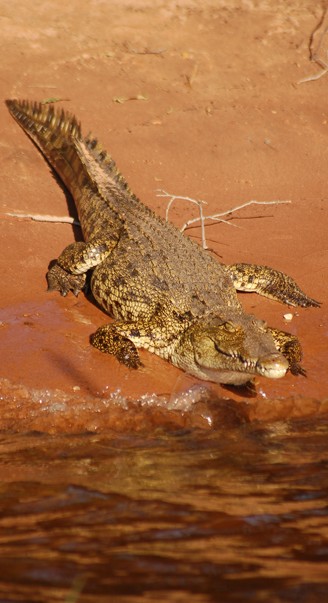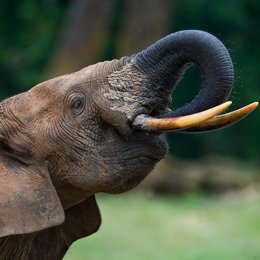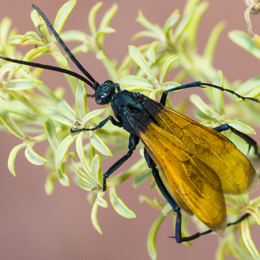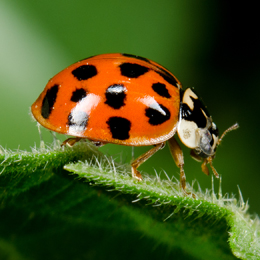Description
The Nile crocodile is widely known as the African crocodile, Ethiopian Crocodile or simply, common crocodile. Though it is lighter in colour than other crocodile species found around the world, it is sometimes referred to as the black crocodile.
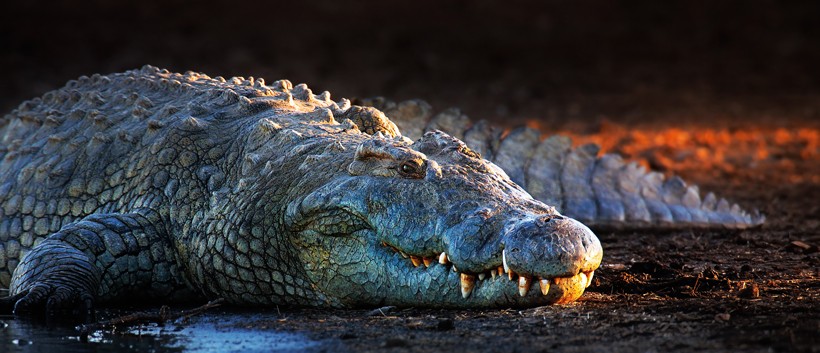
Nile crocodile on a riverbank, last light of day, kruger national park South Africa
?
Image credits: Johan Swanepoel/Shutterstock
The Nile crocodile is a sexually dimorphic animal, which means that the males and females have physical differences. The male Nile croc grows 25%-35% larger than the females, but a female is bulkier than males with the same length. Large males are quite territorial and aggressive in nature. On average, a Nile crocodile can live for up to 70 years even in the wild. However, under suitable conditions they can live for more than 100 years.
The species doesn’t reach an adult size but keeps growing as long as they live. Adult males can be between 2-5 meters long; larger males can weigh close to 700 kilograms. Due to their growth and long lifespan, the upper limit of their age and size is still unknown. There have been proven records of large wild crocs, more than 6 metres in length and 900 kg in weight. Simply, in a suitable condition, the longer they live the larger they get.
It uses its sense of smell and vision to spot prey precisely. Their eyes have vertical slit pupils, which is quite similar to that of a domestic cat. The eyes help them to see clearly, day and night, giving them an upper edge against its prey that can’t see clearly at night. A Nile crocodile also has a very strong sense of smell. It can smell scents left by its prey, or a dead carcass from miles away.

The nose is located on top of the head, enabling the body to stay hidden under water when hunting.
?
Image credits: Radu Bercan/Shutterstock
They are known to track the odour and travel long distances on land, in order to feed on a dead carcass. Additionally to these super-powered senses, the croc has one more special sense. On its entire body, the crocodile has tiny pressure receptors that are called Domed Pressure Receptors. These receptors are clearly visible near the jaws of the crocodile. The tiny black sensory pits near its jaws are connected to nerve fibres, enabling the beast to sense even smallest vibrations in the water. This means that the croc can hunt even if it cannot see the prey with its eyes. This special sense becomes beneficial, especially when the croc goes underwater.
When under water, the Nile crocodile protects its eye with a semi-transparent nictitating membrane, which limits its vision; it also closes its nostrils and ears. Under such circumstances, the only sensory organ that provides precise information is the Domed Pressure Receptors. Just like sharks in the ocean, the croc swims quietly, feeling the water and its small vibrations. Its special sense allows it to estimate the size of the animal and also to pinpoint its position, even when it cannot see, smell or hear anything. 200 million years of evolution, has made this beast invincible on land, on water, and underwater.
There have been many proposals of existing subspecies, but due to lack of data, not a single one is formally recognised. Subspecies like East African Nile crocodile (C. n. Africanus), nominated Ethiopian Bile crocodile (C. n. Niloticus), Madagascar Nile crocodile (C. n. madagascariensis), West African Nile crocodile (C. n. chamses), Kenyan Nile crocodile (C. n. Pauciscutatus), South African Nile crocodile (C. n. Corviei) and West African crocodile or Desert crocodile (C. n. Suchus) have been proposed to be included as subspecies of the Nile crocodile. However, except the West African crocodile (C. n. Suchus) none has been recognized formally. The C. n. Suchus was later recognised as a separate species under the genus Crocodylus and was named C. Suchus. It was always misunderstood as the Nile crocodile due to the similarities between both the species.
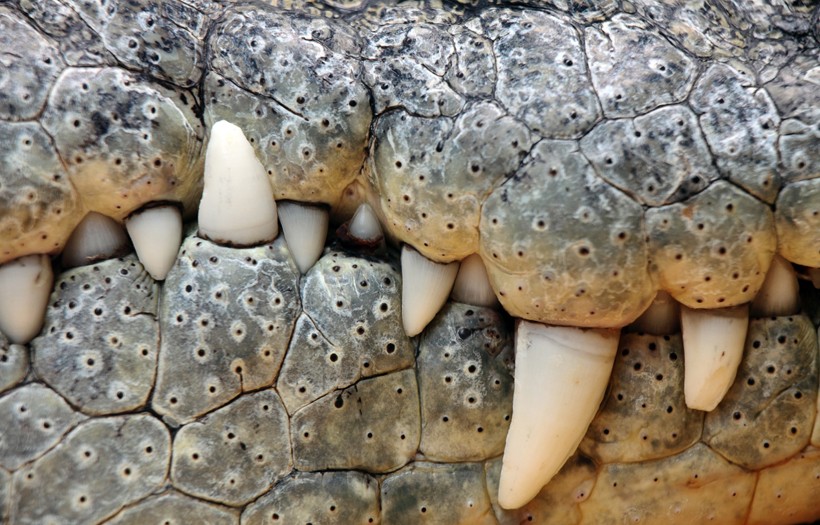
The interlocking jaws of the crocodile are equipped with 60-70 sharp conical teeth
?
Image credits: Enrique Ramos/Shutterstock
Nile Crocodiles have one of the toughest body armours in the wild. It has one of the strongest set of jaws on earth, capable of generating a bite force of 22 kN. The interlocking jaws are equipped heavily with 60-70 sharp conical teeth. Their body is protected by a thick skin covered with scales. The scales do not overlap but are at a uniform distance from one another. These scales are strengthened by bony plates that grow beneath the skin. The scales also increase the crocodile’s surface area in contact with water while swimming, helping them to swim with agility despite being heavy. The tail plays a major role in water. Its muscular spiny tail not only works as a secondary defence mechanism but also assists the croc while swimming.
Habitat & hunting strategy
Although Nile crocodiles can live in salt waters, they prefer the fresh water bodies of Central and Southern Africa. Like all reptiles, the Nile crocodile is a cold-blooded creature and depends on its surroundings to maintain its normal inner temperature. It can be seen basking in the sun in cooler climates, but when the temperatures are high, it undergoes a process similar to hibernation, called Aestivation.
Just like bears and many other creatures, crocodiles reduce/minimize their heart rate and sleep through the harsh seasons. The caves dug by the crocs along the banks of rivers are cooler than the temperatures on the outside. During aestivation, the Nile crocodile takes refuge in the caves and reduces its respiration rate to approximately one breath per minute; the body temperature drops and the heart rate goes down from 40 beats per minute to less than five. In this state the crocodile consumes very little energy, enabling it to survive for more than a year without food.
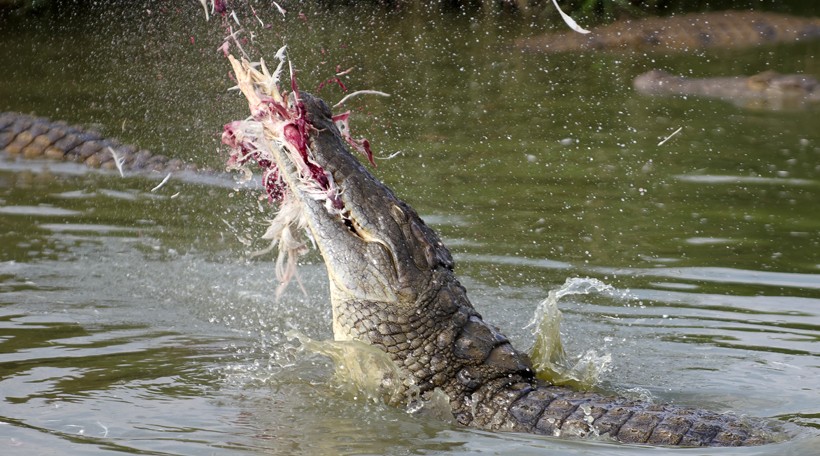
Nile crocodile catching a bird
?
Image credits: Trevor Kelly/Shutterstock
The Nile crocodile is one of the best stealth and ambush predators in the wild. Every animal needs to drink from the river and the croc knows this well. It patiently waits for the animal to come close enough and then plunges out quickly to grab the unsuspecting prey in its strong jaws. It can wait for days for an opportunity, and can stay invisible to the sharpest of all eyes. Its unique head has nostrils, ears and eyes placed on top of its head. This enables it to see, hear and smell its prey while the entire huge body stays hidden under water. Once it spots the prey, the crocodile swiftly dives down without leaving a ripple. It submerges completely by exhaling some air from its lungs and moves closer to the prey. At this time, the special pressure sensing pits enable the crocodile to navigate in the muddy water.
When the prey is in striking range, the 700-kilogram beast unleashes a deadly plunge that can be as fast as 12 metres per second. It settles down on the river bed and then jumps using its legs to start off the plunge. It then uses its strong tail as a propeller to gain more momentum and finally emerges out of the water to grab the prey. Once caught, the crocodile drags the prey to deeper waters and uses its strength to drown the animal to death.
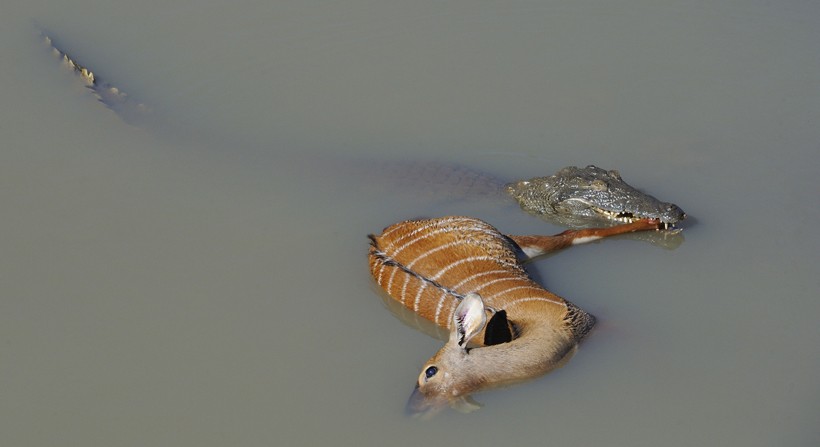
Nile crocodile have a firm hold on the leg of a female nyala, waiting for the exhausted buck to get drowned
?
Image credits: WOLF AVNI/Shutterstock
Crocodiles cannot chew small pieces of meat as their jaws cannot move sideways. So, they simply swallow the prey. Unable to chew or grind the meat, the crocodile swallows rocks that are stored in its stomach. The food is grinded by these rocks to make it easier for digestion. Its digestive system produces concentrated hydrochloric acid that helps the Nile crocodile in digesting almost anything like hoofs, horns, bones, etc. It protects its stomach from the acid by secreting an alkaline solution that neutralises the acid.
When the prey is large, several crocodiles can be seen cooperating to tear the meat apart. The crocodile uses a special technique called the “Death Roll”, to tear chunks of meat from the large prey. They bite the prey and roll fast, eventually tearing out meat from its body. A death roll can easily pull out limbs from the prey’s body. Though they can eat almost anything that comes close enough to the water, the Nile crocs seemingly set their eyes on the annual Wildebeest migration.
The mega-herd consisting of wildebeest, gazelle and zebras can number in millions. Every year they migrate between Tanzania and Kenya, providing thus food to the many predators of Africa. Besides wildebeest, Nile crocodiles also like to feed on gazelle, fish, African water buffalo, birds, baboons and very rarely, baby hippos.
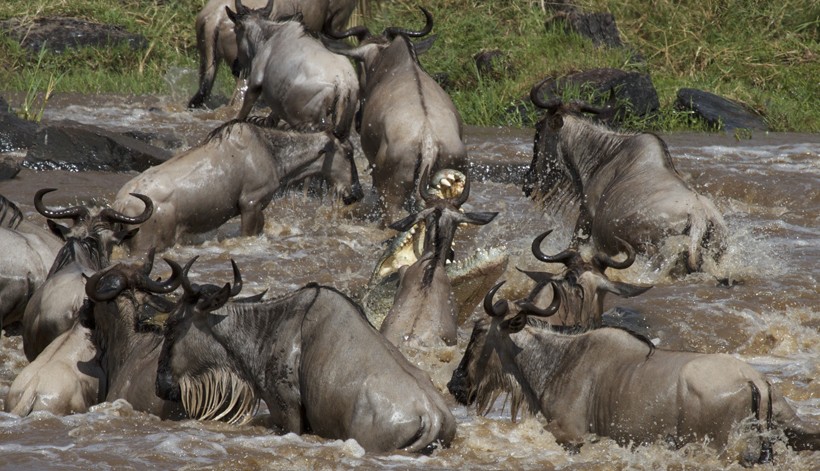
Nile crocodile attacks the wildebeest during the mara river crossing, masai mare, Kenya
?
Image credits: Arturo de Frias/Shutterstock
Due to the harsh conditions in Africa, predators are constantly in conflict with each other. Lions, leopards and hyenas, also hunt on wildebeest, water buffalo, gazelle and other herbivorous animals. Crocodiles often get challenged by these predators and lose their prey to them. On land, the Nile crocodile is very slow and vulnerable; lions and hyenas kill crocs if they find them in a vulnerable state. However in water, there is no animal that can overpower a Nile crocodile; there have been many records of Nile crocodiles killing large predators like lions.
Reproduction and Life Cycle
Nile crocodiles become sexually mature on the basis of their size and not the age. Most males mature once they are above 3 metres in length while females mature when they are between 2-3 metres in length. However, based on the condition of the population in its surroundings, the Nile crocodile tends to change the reproduction patterns.
In areas with a large number of Nile crocodiles and in areas with diminishing numbers, the females have been reported to lay eggs when they are just 1.5 metres in length. This change is not yet understood completely. It is speculated that the early sexual maturity of females may be an evolutionary strategy of crocodiles to boost their numbers under favourable and unfavourable conditions. They prefer mating in a dry climate, but the mating season varies according to the geographical locations of the Nile crocodile habitat.
During the mating season, males become more active and can be seen grunting and hitting their snout in water to make noise. Vocalisations increase and many different sounds can be heard. Large Nile crocodiles can be highly aggressive during this time. They would challenge any rival male and fight fiercely for mating rights. The fight can be occasionally fatal, but mostly the weaker crocodile retreats before any serious damage is inflicted. After mating, a healthy female lays up to 60 eggs in 1-2 months. The eggs are laid down in a nest, which is covered by sand after the eggs are laid. The temperature inside the nest has a major effect on the sexes of the hatchlings.
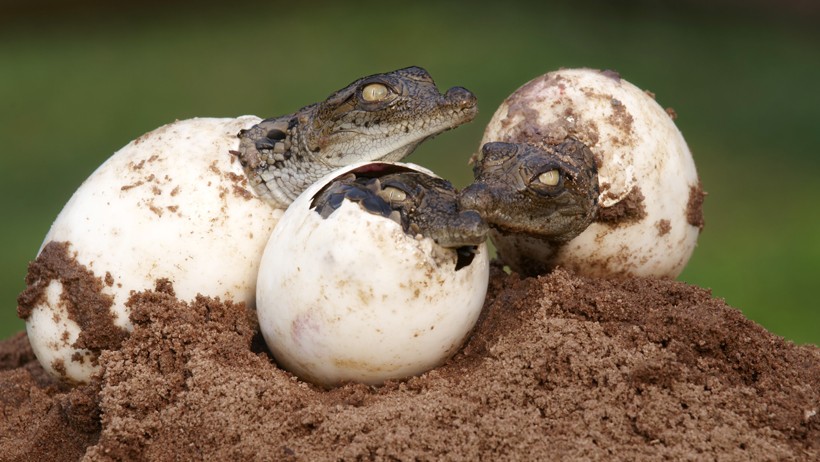
Nile crocodile hatchlings, the gender of the hatchling is determined by the nest temperature
?
Image credits: Trevor Kelly/Shutterstock
Males are born only in the nests that have an inner temperature between 31.7 °C and 34.5 °C; anything below 31.7 °C and above 34.5 °C results in female hatchlings. The female fiercely guards the nest throughout the incubation period. After approximately 90 days of incubation, hatchlings emerge at once.
The Nile crocodile may be the toughest and the largest predator in Africa, but at the beginning of its lifespan, it is one of the easiest prey animals for small predators. A Nile crocodile hatchling measures 10-12 inches in length, making them highly vulnerable to predation.
To avoid predators, the mother quickly gathers all the hatchlings in her mouth and takes them to water. The deadly jaws that can tear anything apart becomes the safest place for crocodile babies. The female crocodile gently carries her babies in her mouth, wherever she goes. She can lock her jaws leaving a 2-inch gap between them so that the hatchlings don’t get bitten accidentally.
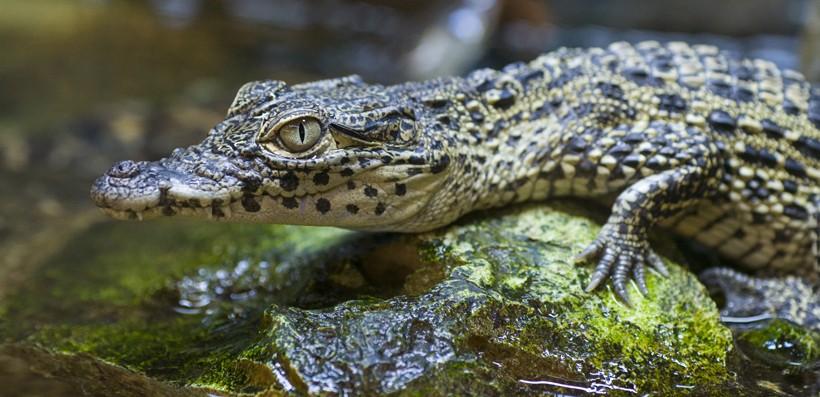
Females look over the hatchlings for the first two years
?
Image credits: NatalieJean/Shutterstock
A Nile crocodile hatchling reaches adulthood in 10-12 years but they can be seen plunging and death-rolling to hunt small insects, from day one. Females look after their hatchlings for the first two years of their lifespan. During this time, the hatchlings are hunted by birds, monitor lizards, snakes, foxes and fish. If there are more nests in the same river back existing, females can form a crèche, where they would collectively take care of all the hatchlings from different mothers. The survival rate of hatchlings is very low, with only 1% surviving to reach adulthood.
Behaviour and Communication
Nile crocodiles are fiercely territorial and aggressive in nature. They can seem slow and sluggish normally, but they are quite fast and agile while hunting and defending. Nile crocodiles spend most of the day basking in the Sun to keep warm. Younger crocodiles spend more time in the water as compared to larger crocodiles.
Despite their heavy bodies, they can travel long distances in search of food. Nile crocodiles can make a wide variety of different noises to communicate with other crocodiles in the region. They are solitary, but during the dry season, several Nile crocodiles can share the same watering hole and also hunt in the same territory.

Nile crocodile basking in the sun, South Africa
?
Image credits: EcoPrint/Shutterstock
Nile crocodiles are also known to form relationships with other species that share its habitat. Mostly, African hippos and Nile crocs are found in same waters but they keep their distance. A Nile crocodile can hunt on baby hippos but it stays away from large males and females. It has a very mysterious symbiotic relationship with the Egyptian Plover. The small bird enters the mouth of the crocodile and feeds on bits of meat stuck between its teeth. This happens usually when the croc is basking with its mouth wide open.
Crocodiles are highly adaptable and very smart reptiles that outlived the dinosaurs. Over the several million years of evolution, this species has optimized its ways to survive under harshest conditions. Their advanced senses and the ability to use them to take down any potential prey clearly indicates that they are highly intelligent.
Population and Conservation
Nile Crocodiles are found in Central and Southern Africa. They inhabit rivers, lakes, ponds and seasonal watering holes in the savanna. It is speculated that once they inhabited the entire continent, along with the northern dry regions of Africa. However, the species later got regionally extinct from the northern parts of Africa.
The Nile crocodile was for a long time considered to be the only crocodile species existing in Africa. But recent studies proved the existence of C. Suchus or Desert crocodile, which was continuously misunderstood as the Nile crocodile.
Nile crocodiles flourish in the African continent and are not under any conservation measures at the moment, even though they were once on the edge of extinction. Till the year 1990, the IUCN listed the Nile crocodile as “vulnerable”. However, with a little help from dedicated wildlife conservationists, the crocs grew strong in numbers from that time on. Due to human activity in Nile crocodile habitat and the animal’s nature to hunt anything that approaches a water hole, human confrontations occur very often. They are hunted for illegal trade of their skin, bone and teeth.
Nile crocodiles live in the harsh African continent and are also dependent on water. Climate changes and extended dry seasons arising due to factors like global warming and pollution are also some of the major threats to the Nile crocodile population.
Nile crocodiles have been fascinating humans since the ancient times. The Egyptians believed in a very powerful and protective god of the Nile, named as Sobek or Suchos. He was often depicted as a Nile crocodile or as a human with the head of a crocodile.
Sobek was worshiped as the god of fertility, power and warfare. Several statues, paintings, carvings and texts depicting the god Suchos, have been discovered by the archeologists in Egypt.
Evolution
Crocodiles have a very rich evolutionary history that dates from 200 million years ago. Archosaurus or the Ruling lizards are considered to be the ancestors of dinosaurs and crocodiles. Well-preserved fossils of Archosaurus, that date back up to 250 million years ago have been unearthed by scientists. Though dinosaurs and crocodiles resembled each other very closely, there were noticeable physical differences between both the species.

The development of muscular jaws proved effective
?
Image credits: Nagel Photography/Shutterstock
The crocs’ muscular jaws and wider positioning of the limbs proved to be more effective. With the help of these physical abilities, the early crocodiles managed to outlive the dinosaurs by a huge margin.
The early crocodiles preferred a terrestrial lifestyle. Approximately 200 million years ago all crocodiles moved to a marine lifestyle, due to the availability of food and resources. Slowly the species evolved and formed the current physical structure, which is quite streamlined to help them survive in water. Over the last 60 million years, the crocodiles have become smaller compared to their early ancestors; but they haven’t changed much their physical characteristics. Scientists speculate that if the conditions are good in future, there is a possibility that the giant crocodiles may once again rule the planet.
Funfacts
- A Nile crocodile can hunt even if it cannot see, hear or smell its prey.
- It is one of the largest predators on the planet, capable of weighing close to 700 kg.
- Nile crocodiles can digest horns, bones and hoofs of animals.
- Its jaws may shut with tremendous force and speed, but the muscles used for opening it are pretty weak.
- Its bite force has been measured to be up to 22 kN but it can be a lot higher depending on the mood of the crocodile.
- Only soft spot on a crocodile’s body is the thin skin underneath its body, but the croc never shows its belly.
- Crocodiles have been on top of the food chain for the past 3 million years.
- A crocodile can live without food for up to a year.
- Hippos and Nile crocs share the same habitat, but they rarely fight.
- The Egyptian plover bird is known to enter the mouth of a crocodile without being bitten.
